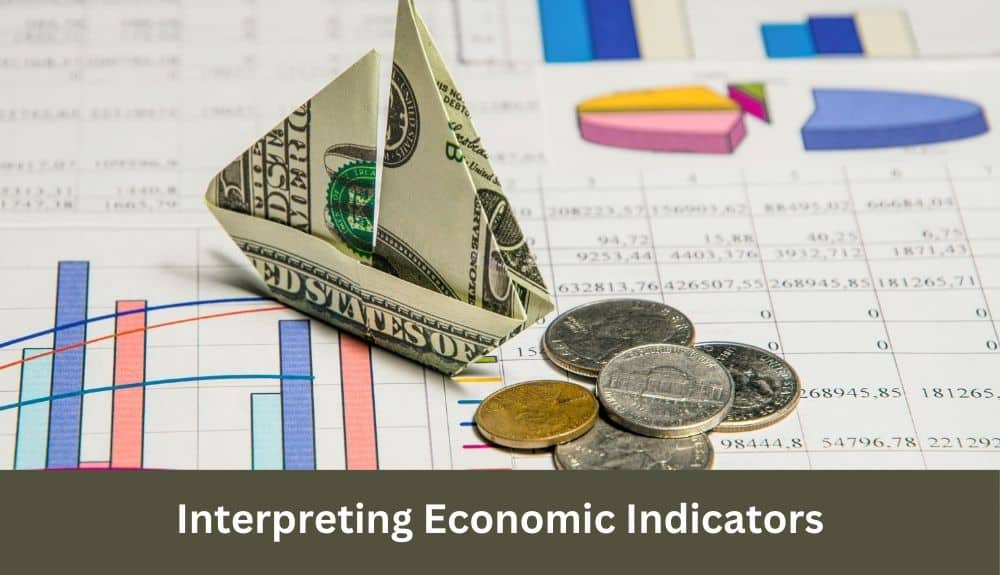Have you ever wondered how the pulse of the economy directs the flow of your investments? Picture this: a sudden spike in unemployment rates rattles the stock market, causing a whirlwind of uncertainty among investors. This scenario vividly exemplifies the profound impact economic indicators hold over investment decisions.
Economic indicators serve as the compass guiding savvy investors through the volatile terrain of the financial landscape. They offer a window into the underlying economic factors shaping market conditions, helping investors make informed choices amidst fluctuating uncertainties. In this blog, we delve deep into the realm of economic indicators, unraveling their significance and dissecting their influence on investment strategies.
Throughout this comprehensive guide, we will explore the various types of economic indicators, decode their complex signals, and unveil strategies to leverage this valuable data effectively. Join us on this journey to demystify the correlation between economic indicators and successful investment decisions, empowering you to navigate the markets with confidence and foresight. Uncover the secrets that transform data into actionable insights for profitable investments.
Introduction to Economic Indicators
Economic indicators play a vital role in the world of investment decision-making. They provide valuable insights into the health and performance of an economy, helping investors identify profitable opportunities and make informed choices. Understanding the significance of economic indicators is crucial for navigating the complex landscape of financial markets.
At its core, an economic indicator is a statistical data point that provides information about the overall economic activity of a country or region. These indicators can range from gross domestic product (GDP) growth rate to inflation rate, unemployment rate, consumer spending, trade balance, and more. By tracking and analyzing these indicators, investors gain valuable insights into the underlying economic factors that influence various asset classes, such as stocks, real estate, and currencies.
Economic indicators are widely used by savvy investors to gauge the current state of the economy and anticipate future trends. They act as indicators of potential risks and opportunities, allowing investors to make more informed decisions. For example, a rising unemployment rate may indicate a downturn in consumer spending and a potential slowdown in economic growth, signaling caution for investors.
It is important to note that economic indicators are produced by government agencies, central banks, and other reputable sources. These organizations use rigorous methodologies and data collection techniques to ensure the accuracy and reliability of the indicators. As a result, investors can have confidence in the information provided by these indicators as they are based on extensive research and analysis.
In conclusion, economic indicators are crucial tools for investment decision-making. They provide valuable insights into the overall health and performance of an economy, helping investors assess risks, identify opportunities, and make informed choices. It is essential for investors to understand the significance of economic indicators and incorporate them into their investment strategies for successful outcomes. So, let’s dive deeper into the world of economic indicators and explore their different types and how to interpret them effectively.
Definition and Types of Economic Indicators
Economic indicators play a crucial role in guiding investment decisions. These indicators provide valuable insights into the health and performance of an economy, helping investors identify profitable opportunities and manage potential risks. In this section, we will explore the definition of economic indicators and delve into the various types that investors rely on.
Definition of Economic Indicators
Economic indicators are statistical data points or metrics that provide information about various aspects of an economy. They are used to gauge the overall economic performance, trends, and potential future outcomes. These indicators are typically measured and published by government agencies, central banks, or reputable research institutions.
In simple terms, economic indicators are like signposts that help investors navigate the complex world of finance. They offer a snapshot of the economy’s current state and can be used to anticipate its direction. By analyzing economic indicators, investors can gain valuable insights into the overall economic conditions of a country or region, which can inform their investment decisions.
Types of Economic Indicators
1. Leading Indicators: Leading indicators are economic data points that change before the overall economy does. They are used to predict changes in economic activity and can help investors identify turning points in the business cycle. Examples of leading indicators include stock market indexes, building permits, and consumer sentiment surveys.
2. Coincident Indicators: Coincident indicators move in tandem with the overall economy and provide a real-time depiction of its current state. These indicators confirm or validate the current economic conditions. Examples of coincident indicators include employment levels, industrial production, and retail sales.
3. Lagging Indicators: Lagging indicators are economic data points that change after the overall economy has already shifted. They reflect past economic activity and are often used to confirm or validate a trend. Examples of lagging indicators include the unemployment rate, inflation rate, and interest rates set by central banks.
It’s important to note that different economic indicators serve different purposes and provide unique insights. Understanding the various types of economic indicators and their respective roles in the investment decision-making process is crucial for investors who aim to make informed choices.
By analyzing a combination of leading, coincident, and lagging indicators, investors can gain a comprehensive understanding of an economy’s current state, anticipate future trends, and better position themselves to seize investment opportunities or manage potential risks.
Remember, economic indicators are just one piece of the puzzle in the realm of investment decision-making. To make well-rounded investment choices, savvy investors leverage economic indicators alongside other factors such as company analysis, market trends, and risk assessment. So let’s delve further into interpreting economic indicators and uncover how they can inform and shape investment decisions.
Interpreting Economic Indicators

Interpreting economic indicators plays a crucial role in making informed investment decisions. These indicators provide valuable insights into the overall health and performance of the economy, helping investors identify trends, opportunities, and potential risks. By understanding how to interpret these indicators, investors can gain a competitive edge in the realm of investment decision-making. Here are some key considerations when it comes to interpreting economic indicators:
Familiarize Yourself with the Indicator
Before diving into the interpretation process, it’s essential to have a clear understanding of the economic indicator in question. Each indicator provides specific information about different aspects of the economy. For example, the GDP growth rate reflects the overall economic growth, while the unemployment rate indicates the labor market conditions. By familiarizing yourself with the indicators and their definitions, you can better grasp their implications.
Look for Trends and Patterns
When analyzing economic indicators, it’s important to look for trends and patterns over time. By tracking the historical data of a particular indicator, you can identify recurring patterns and determine whether the current readings deviate from the norm. Sudden fluctuations or a series of consecutive changes may indicate shifts in the economy that could affect investment opportunities.
Consider the Interrelationships
Economic indicators do not exist in isolation. They often have interrelationships with one another. For example, a rise in consumer spending may suggest increased confidence in the economy, which, in turn, could lead to stronger business investments. By considering the relationships between various indicators, investors can gather a more holistic view of the economy and better predict its future direction.
Compare Against Expectations
Interpreting economic indicators involves comparing the reported data against market expectations. Analysts and economists often make predictions about the direction and magnitude of the indicators. When the reported data differs significantly from these expectations, it can signal unexpected changes or events in the economy, influencing investment decisions. Understanding market expectations helps investors contextualize the current readings and form more accurate assessments.
Take a Forward-Looking Perspective
While economic indicators provide past and current information, they can also offer insights into future trends. Leading indicators, such as building permits or consumer confidence surveys, can indicate the direction the economy is likely to take. By analyzing leading indicators, investors can anticipate changes and make early investment decisions to capitalize on emerging opportunities or mitigate potential risks.
Seek Expert Opinions and Analysis
Interpreting economic indicators can be complex and requires expertise. It’s advisable to seek expert opinions and analysis from reputable sources. Economists, financial analysts, and research institutions often provide in-depth interpretations, forecasts, and commentary on economic indicators. Incorporating these insights into your analysis can enhance your understanding and decision-making process.
By mastering the art of interpreting economic indicators, investors can leverage these valuable tools to identify profitable investment opportunities, assess market conditions, and make informed choices. Remember to consider the macroeconomic context, monitor changes, and adapt your investment strategy accordingly.
The Most Important Economic Indicators
When it comes to investment analysis, certain economic indicators carry significant weight and are considered vital in providing insights into the overall health of the economy. These indicators serve as important reference points for investors looking to make informed decisions. Understanding and interpreting these indicators can give you a competitive edge and help you identify profitable opportunities. Here are some of the key economic indicators widely regarded as crucial for investment analysis:
1. Gross Domestic Product (GDP)
– GDP measures the monetary value of all goods and services produced within a country’s borders. It is considered a primary indicator of economic health and growth. Changes in GDP can signal expansion or contraction of an economy, providing valuable insights for investment decisions.
2. Unemployment Rate
– The unemployment rate reflects the percentage of the labor force that is unemployed and actively seeking employment. A low unemployment rate generally indicates a strong economy and increased consumer spending, signaling potential growth in various sectors.
3. Consumer Price Index (CPI)
– The CPI measures changes in the average prices of goods and services bought by households. It is used to gauge inflation or deflation and its impact on purchasing power. Investors closely monitor CPI to assess potential risks and make adjustments to their portfolios.
4. Interest Rates
– Changes in interest rates, particularly those set by central banks, can significantly impact various sectors of the economy. Lower interest rates can stimulate borrowing and economic growth, while higher rates can slow down spending and investment. Investors analyze interest rate movements to evaluate potential opportunities and risks.
5. Stock Market Performance
– The performance of stock markets, such as major indices like the S&P 500 or the Dow Jones Industrial Average, serve as barometers of overall economic activity. Investors often track stock market performance as a reflection of market sentiment and potential investment trends.
6. Housing Market Indicators
– Indicators related to the housing market, such as home sales, housing starts, and mortgage rates, provide insights into the overall health of the real estate sector. A robust housing market can indicate a thriving economy and potential investment opportunities in the real estate industry.
It’s important to note that these indicators don’t work in isolation, and their implications on investment decisions should be analyzed in conjunction with other factors such as government policies, international trade, and specific industry trends. By keeping a close eye on these key economic indicators, investors can gain valuable insights and make more informed decisions in the realm of investment.
Remember, incorporating economic indicators into your investment strategy is not about having a crystal ball but rather about using available data to increase your chances of success.
Impact of Economic Indicators on Investment Decisions
Economic indicators play a crucial role in shaping investment decisions, as they provide valuable insights into the current state and future outlook of the economy. By understanding and analyzing these indicators, investors can make informed choices that align with market trends and potential opportunities.
Interpreting Economic Indicators
To fully comprehend the impact of economic indicators on investment decisions, it’s important to first understand how to interpret them. Each indicator represents a specific aspect of the economy, such as employment, inflation, or consumer spending. Analyzing these indicators requires a combination of statistical analysis, historical context, and a thorough understanding of economic theory.
Real-Life Examples
Let’s consider a few real-life examples to illustrate how economic indicators can shape investment decisions. The unemployment rate, for instance, serves as a barometer of economic health. When unemployment is low, it suggests increased job stability and consumer confidence, signaling a potential rise in consumer spending. Investors may choose to invest in industries such as retail, hospitality, or consumer goods, anticipating an upward trend in demand.
Similarly, changes in interest rates can greatly impact investment decisions. When central banks lower interest rates, borrowing becomes cheaper, which in turn can stimulate economic growth. Investors may interpret this as an opportune time to invest in sectors such as real estate or housing, as lower interest rates often lead to increased demand for mortgages and property.
Considerations and Strategies
While economic indicators offer valuable insights, it’s important to recognize their limitations and consider multiple factors when making investment decisions. Economic indicators provide a snapshot of the current economic climate, but they don’t guarantee future performance. Investors should approach these indicators as one piece of the puzzle, incorporating additional research, analysis, and personalized strategies.
Conclusion
Economic indicators serve as powerful tools for investors, enabling them to make informed decisions based on current economic conditions. By diligently analyzing and interpreting these indicators, investors gain a competitive edge, identifying potential risks and opportunities within the market. However, it’s imperative to remember that economic indicators are just one aspect of the investment decision-making process. A comprehensive approach that incorporates various factors and strategies is key to successful investing.
Incorporating Economic Indicators Into Investment Strategy

When it comes to making informed investment decisions, incorporating economic indicators into your strategy is crucial. Economic indicators are key statistics and data points that provide insights into the health and performance of an economy. They can help investors gauge the overall economic conditions, identify trends, and predict potential opportunities or risks. Here are some tips and strategies to effectively incorporate economic indicators into your investment strategy:
1. Stay Up-to-Date: Keep track of the latest economic indicators by following reputable sources such as government agencies, central banks, and financial news outlets. Stay informed about releases of important data like gross domestic product (GDP) growth, unemployment rates, inflation rates, and interest rate decisions. This will give you a solid foundation for your investment decisions.
2. Understand the Relationship: Study the relationship between economic indicators and different asset classes. Certain indicators may have a stronger impact on specific investments. For example, interest rate changes can significantly affect bonds and real estate, while consumer spending patterns may impact retail and consumer goods sectors. Recognizing these connections will help you anticipate market movements and adjust your portfolio accordingly.
3. Use Leading Indicators: Leading indicators provide insights into potential future trends and can be valuable for timing your investments. By identifying leading indicators, you may get a head start on spotting opportunities or detecting possible downturns. Some commonly used leading indicators include stock market performance, business confidence surveys, and housing starts.
4. Diversify Your Indicators: Relying on a single economic indicator may not provide a comprehensive picture of the economy. Instead, consider analyzing a range of indicators to gain a broader perspective. Look at indicators from different sectors, such as employment, trade, and manufacturing. By diversifying your indicators, you can reduce the risk of making decisions based on incomplete or biased data.
5. Consider Historical Relationships: Study historical relationships between economic indicators and market performance. By analyzing past patterns, you may identify correlations and trends that can guide your decision-making process. However, keep in mind that historical relationships are not foolproof predictors and should be used in conjunction with other factors.
6. Adjust Your Strategy: Economic indicators can sometimes signal changes in economic conditions that may require adjustments to your investment strategy. For example, if indicators suggest a slowdown in the economy, you might consider rebalancing your portfolio by reducing exposure to cyclical sectors and increasing investments in defensive assets.
Remember, incorporating economic indicators into your investment strategy is an ongoing process. Regularly reviewing and reassessing your strategy based on current economic conditions and indicators will help ensure that your portfolio remains aligned with the prevailing market trends. By staying abreast of economic indicators and employing a well-informed approach, you can enhance your investment decisions and potentially achieve better outcomes in the long run.
Pros and Cons of Economic Indicators
When it comes to making investment decisions, economic indicators play a crucial role in providing valuable insights into the health of the economy. However, it’s important to understand the pros and cons of relying on these indicators to ensure informed decision-making. Let’s explore the advantages and limitations of economic indicators in investment decision-making.
Advantages of Economic Indicators
1. Data-driven analysis: Economic indicators provide objective and reliable data that can be analyzed to assess the current and future state of the economy. This data-driven approach helps investors make informed decisions based on concrete evidence rather than relying on speculation or intuition.
2. Early warning signals: Leading economic indicators, such as stock market trends or changes in consumer spending, can serve as early warning signals for potential shifts in the economy. By closely monitoring these indicators, savvy investors can identify opportunities and make proactive adjustments to their investment strategies.
3. Insights into government policies: Economic indicators often reflect the impact of government policies and actions. For instance, changes in interest rates or fiscal policies can significantly influence investment opportunities. By analyzing economic indicators, investors can gain insights into the potential effects of government actions on specific sectors or asset classes.
4. Macro-level perspective: Economic indicators provide a macro-level perspective on the overall health of the economy. They take into account factors such as GDP growth, unemployment rates, and inflation, which can help investors gauge the overall economic climate and make better-informed investment decisions.
Limitations of Economic Indicators
1. Delayed information: Economic indicators are typically released with a time lag, which means that the data reflects past economic conditions rather than real-time information. This delay can limit their effectiveness in capturing rapid changes or fluctuations in the economy.
2. Complexity and interpretation: Interpreting economic indicators requires a deep understanding of economic theory and statistical analysis. Misinterpretation or improper analysis of the data can lead to erroneous investment decisions. It is crucial for investors to have a solid grasp of the underlying concepts and methodologies used in calculating these indicators.
3. Influence of external factors: Economic indicators can be influenced by multiple external factors that may not directly correspond to investment opportunities. Factors like political events, natural disasters, or global economic trends can impact economic indicators and create misleading signals for investors.
4. Limited scope: Economic indicators provide a snapshot of the overall economy but may not capture the nuances and specific factors relevant to individual sectors or industries. Investors need to supplement economic indicators with industry-specific data and analysis to make more accurate investment decisions.
In conclusion, economic indicators offer valuable insights for investment decision-making, but they come with their own set of pros and cons. By understanding the advantages and limitations of these indicators, investors can effectively incorporate them into their investment strategies and make more informed decisions.
Conclusion
In conclusion, understanding and leveraging economic indicators is crucial for making informed investment decisions. Throughout this guide, we have explored the significance of economic indicators in investment decision-making and delved into various types of economic indicators.
By interpreting economic indicators accurately, investors can gain valuable insights into the health of the economy, anticipate market trends, and identify profitable opportunities. These indicators provide a snapshot of economic activity, such as the unemployment rate, inflation rate, GDP growth, and trade deficits or surpluses. By monitoring these indicators, investors can make more informed decisions about asset allocation, investment timing, and risk management.
Incorporating economic indicators into an investment strategy can provide a competitive edge. Successful investors recognize the importance of keeping a keen eye on economic data to gauge the overall market sentiment and potential risks. By correctly interpreting leading indicators, such as consumer spending and interest rates, investors can position themselves ahead of market movements and capitalize on emerging trends.
However, it is important to note that economic indicators have their limitations. They are not infallible predictors and should be used in conjunction with other fundamental and technical analyses. It is also crucial to stay updated with the latest economic data and adapt investment strategies accordingly.
To succeed in the realm of investment decision-making, savvy investors must grasp the intricacies of economic indicators, interpret them accurately, and use them as a crucial tool for making well-informed investment decisions. Understanding the role of economic analysis and effectively incorporating economic indicators into investment strategies can significantly enhance the likelihood of achieving successful investment outcomes.
In summary, embracing the valuable insights that economic indicators provide can help investors navigate the dynamic world of investing with confidence and increase the potential for prosperous and profitable investment decisions.






